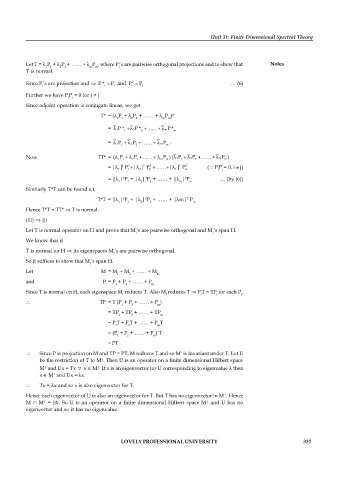Page 344 - DMTH505_MEASURE_THEOREY_AND_FUNCTIONAL_ANALYSIS
P. 344
Unit 31: Finite Dimensional Spectral Theory
Let T = P + P + …… + P , where P ’s are pairwise orthogonal projections and to show that Notes
1 1 2 2 m m i
T is normal.
Since P ’s are projection and P * P and P 2 P … (6)
i i i i i
Further we have P P = 0 for i j
i j
Since adjoint operation is conjugate linear, we get
T* = ( P + P + …… + P )*
1 1 2 2 m m
= 1P * 1 2P * 2 mP * m
= 1P 1 2P 2 mP .
m
Now TT* = ( P 1 2 P 2 m P )( 1P 1 2P 2 mP )
m
m
1
2
2
2
2
= | | P | | P 2 | | P 2 ( P P = 0, i j)
1 1 2 2 1 m i j
2
= | | P + | | P + …… + | | P … (by (6))
2
2
1 1 2 2 m m
Similarly T*T can be found s.t.
2
2
2
T*T = | | P + | | P + …… + | m| P
1 1 2 2 m
Hence T*T = TT* T is normal.
(iii) (i)
Let T is normal operator on H and prove that M ’s are pairwise orthogonal and M ’s span H.
i i
We know that if
T is normal on H its eigenspaces M ’s are pairwise orthogonal.
i
So it suffices to show that M ’s span H.
i
Let M = M + M + …… + M
1 2 m
and P = P + P + …… + P
1 2 m
Since T is normal on H, each eigenspace M reduces T. Also M reduces T P T = TP for each P .
i i i i i
TP = T (P + P + …… + P )
1 2 m
= TP + TP + …… + TP
1 2 m
= P T + P T + …… + P T
1 2 m
= (P + P + …… + P ) T
1 2 m
= PT
Since P is projection on M and TP = PT, M reduces T and so M is invariant under T. Let U
be the restriction of T to M . Then U is an operator on a finite dimensional Hilbert space
M and Ux = Tx x M . If x is an eigenvector for U corresponding to eigenvalue then
x M and Ux = x.
Tx = x and so x is also eigenvector for T.
Hence each eigenvector of U is also an eigenvector for T. But T has no eigenvector in M . Hence
M M = {0}. So U is an operator on a finite dimensional Hilbert space M and U has no
eigenvector and so it has no eigenvalue.
LOVELY PROFESSIONAL UNIVERSITY 337

